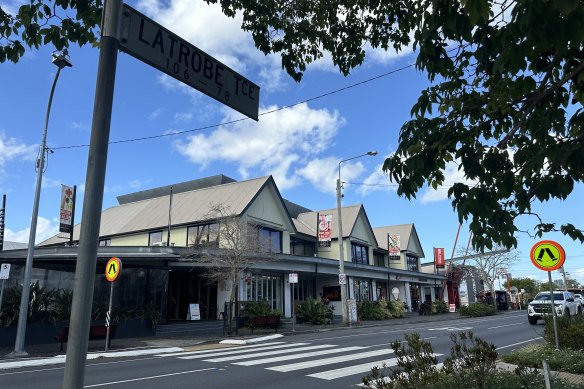- Exclusive
- National
- Queensland
- City life
This was published 9 months ago
‘Absolute mayhem’: The most dangerous zebra crossing in Brisbane
Latrobe Terrace in Paddington is one of Brisbane’s trendiest streets – and home to the city’s most dangerous zebra crossing.
Exclusive analysis by Brisbane Times can reveal five pedestrians have been hit by cars at the zebra crossing outside Paddington Central since 2003, resulting in hospitalisation and injuries.
Four rear-end car crashes have been officially recorded. But that doesn’t include numerous near-hits or incidents not reported to police, and locals we spoke to said they regularly witnessed crashes and cars not stopping.

Ken Roney, who has lived in Paddington for over 20 years, has long called for this dangerous crossing to be improved. Credit: Felicity Caldwell
Experts say reducing the speed limit from 50km/h to 30km/h, transforming the area into a “high street”, and installing a raised crossing would not only improve safety, it could bring suburban shopping and dining strips back to life.
Ken Roney, who has lived in Paddington for more than 20 years, said the crossing was “just scary”.
“I would say one out of four times I cross that crossing, a car will go straight through it with me on the crossing,” he said.

The highest number of pedestrians hit by cars in Brisbane was recorded at this Latrobe Terrace crossing.Credit: Felicity Caldwell
Paddington resident Arlo Haycroft said he’d seen at least 15 car crashes at the site, including one rear-end collision that happened while he was crossing the road with his girlfriend.
“The car behind wasn’t paying attention and slammed into that one – they could have easily cleaned us both up,” he said.
“The sun is right in your eye coming this way. People coming down the hill just aren’t paying attention and are often speeding … people [turning on to Latrobe Terrace] are trying to do hill starts around a blind corner.
“It’s absolute mayhem most of the time.”
Brisbane City Council improved warning signs at the crossing late last year, but has resisted calls for a speed-bump-style “wombat crossing”, which would be the same level as the footpath.
“Latrobe Terrace is designed to carry high volumes of traffic and connect suburban areas to arterial roads,” a council spokeswoman said.
“Given this function, it is not suitable for raised speed platforms such as wombat crossings.”
But Roney questioned why a raised crossing could not be added.

Greens councillor for Paddington Seal Chong Wah says the signs at the Latrobe Terrace crossing don’t stand out.Credit: Felicity Caldwell
“They’ve got to slow down anyway if there’s anyone on the crossing,” he said.
Road safety expert Professor Narelle Haworth, from QUT’s Centre for Accident Research and Road Safety-Queensland, said the speed limit should be reduced to 30km/h – or at least 40km/h.
“If a pedestrian is hit at more than 30km/h, a fatality or serious injury is almost inevitable,” she said.
But Haworth said that should be reinforced with a raised crossing and other improvements, such as narrowing the road and extending the curb to reduce the distance to cross.
“It’s somewhere for people to gather,” she said.
“It’s also clear to motorists that it’s not a place for going fast – it’s not a place for movement, it’s a place for staying.
“Not only does that improve the safety for the pedestrians, it also makes the place more welcoming and can result in better business for the restaurants and cafes.”
Haworth said the answer did not have to be a signalised crossing.
“Often what happens when we put in signalised intersections is to give most of the priority to the cars, and we’re actually discouraging pedestrians from crossing when it’s green,” she said.
“So we’re promoting non-compliance by just making pedestrians wait when they shouldn’t have to wait.”
Queensland Walks president Greg Vann agreed a high-street treatment and wombat crossing would signal to drivers that it was a pedestrian area.
“Latrobe Terrace has some wonderful local businesses,” he said.
“We could reimagine streets like that to turn them into beautiful high streets that make them real people places – safe and lively places that support thriving suburban dining and shopping destinations.”
Greens councillor for Paddington Seal Chong Wah said the section of road could be 40km/h and narrowed to provide more public space, arguing the wide road coming into the crossing from the east encouraged higher speeds.
“The style of crossings in Brisbane are very outdated, like this one at Paddington Central, with no use of colour, virtually no raised wombat crossings, and even the signs do not stand out,” she said.
“Paddington Central is a prime example of where a wombat raised crossing would be ideal.”
There are about 440 zebra crossings in Brisbane. Other hot spots for pedestrians being hit were Queen Street in the city and James Street in Fortitude Valley.
A council spokeswoman said there was no policy to phase them out.
“Pedestrian refuge islands are frequently used as part of transport improvement projects, however zebra crossings continue to be used in accordance with the Queensland government’s [guidelines],” she said.
Start the day with a summary of the day’s most important and interesting stories, analysis and insights. Sign up for our Morning Edition newsletter.